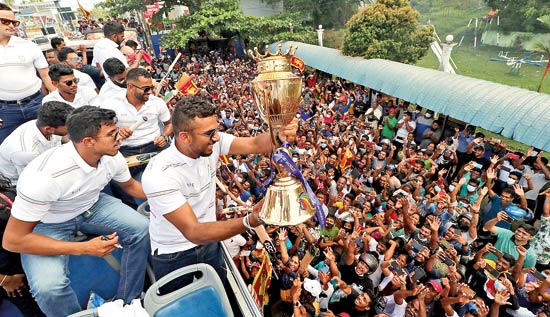2022: When Sri Lanka men grasped the desert rose
In early 2022, Sri Lankans faced power cuts and dire shortages of essentials. Daily life was a struggle, and protests broke out as the nation endured some of its harshest days.
Yet, by September that year, the streets rang with a very different kind of noise. Drums, horns, fireworks, and songs of celebration filled the air. For once, the chants were not against politicians but in respect of an improbable sporting triumph: Sri Lanka’s Asia Cup victory.
At a time when the island nation was reeling from its worst economic crisis in decades, with families queuing for hours for fuel and medicine and young people considering migration as their only option, the men’s cricket team offered something priceless. They offered joy.

The Asia Cup trump in 2022 was more than a relief for all Sri Lankans alike, who were battered by unending chaos - File pic
“I don’t think anyone gave us a chance and neither were we hoping to win. Rather, our focus was on taking each match, one by one, and doing well on that particular day,” recalled Dasun Shanaka, while walking to the dressing room after a grueling batting session in the nets here at Abu Dhabi Sports City.
Sri Lanka’s economic collapse was not just numbers on a balance sheet. It meant empty petrol stations, dark homes, and parents going hungry so their children could eat. It meant the fall of the mighty Rajapaksa dynasty, with a President fleeing as enraged protestors occupied his residence. Against this backdrop, cricket might have seemed a luxury.
History, however, has shown that sport can soothe wounds the way politics and economics cannot. Cricket has long held a sacred place in Sri Lanka’s national psyche. From the glory of the 1996 World Cup to Sanath Jayasuriya’s explosive batting, it has provided moments of collective joy, transcending ethnic, religious, and political divides. It did this once more, in 2022.
Sri Lanka’s participation in the Asia Cup in the UAE was itself remarkable. Originally scheduled to be held at home, the tournament was shifted due to the nation’s turmoil. The team arrived without star power, expectation, or smooth preparation. Many braced for embarrassment, not triumph.
“People were genuinely fed up with cricket in our country. So, what we had to show was how good we were as a team and how well we can perform. We did that,” Shanaka said.
The opening match seemed to confirm the worst fears. Sri Lanka were dismantled by Afghanistan, a lower-ranked team, losing by 8 wickets with 59 balls to spare. Pundits began writing obituaries before the campaign had begun.
“It was a bad loss,” recalled Pramodya Wickremasinghe, Chairman of Selectors at the time.
“But we knew our strengths. We planned properly, motivated the players. No one expected much, but we delivered.”
From that low point emerged resilience. Narrow wins against Bangladesh and India reignited hope. This was no longer the timid, inconsistent Sri Lanka of preceding years. It was a team that fielded like their lives depended on it, unafraid of reputations and strengthened by adversity.
“We were building a new team,” Wickremasinghe explained.
“Other teams had experienced players, but we went with a young side because we were already losing with the seniors. I took responsibility for including players like Pathum Nissanka even when some said he wasn’t ready.”
The turnaround became clear against cricket giants. Against India, the pre-tournament favourites, Sri Lanka held their nerve in a tense run chase, cheered on by expatriate fans. Against Pakistan, the tournament’s most consistent team, Sri Lanka played with freedom and courage, setting up a final few had predicted.
In the final, Pakistan were expected to dominate. Instead, Sri Lanka showcased belief. Bhanuka Rajapaksa’s heroic 71, not out, lifted them from early trouble, Wanindu Hasaranga struck crucial blows with the ball, and fielding tightened relentlessly. Pakistan crumbled, and with them went months of despair weighing on Sri Lankans. The Asia Cup returned home for the first time in eight years.
“To be able to lead and win it, that’s an indescribable feeling. I never expected the captaincy and to lead and win a tournament like that with a young team was incredible. It was a team effort. Everyone contributed and that’s what it takes to win tournaments—not individual brilliances but a collective effort,” Shanaka added.
Scenes in Colombo were extraordinary. Open-top buses carried the victorious team through streets overflowing with cheering crowds. Strangers embraced. Flags waved from rooftops. For a few hours, the island forgot power cuts and fuel queues. Smiles were unforced, laughter genuine.
“It was unbelievable,” Wickremasinghe said.
“This wasn’t a World Cup, but people responded passionately. It was a chance for them to release the pressure of all the hardships. For us, it was an opportunity to bring a smile to their faces.”
The 2022 Asia Cup was more than a trophy. It symbolised resilience, unity, and refusal to be defined by crisis. Sport mirrored society, and Sri Lanka’s cricket journey reflected its people: battered but unbroken, dismissed but defiant. The absence of superstars became a strength. Every player contributed, echoing how ordinary Sri Lankans banded together to survive economic turmoil.
“As selectors, we faced pressure for dropping senior players and bringing in young talent. This was our chance to prove the detractors wrong and show that the game is bigger than everything else,” he continued.
For younger generations, the triumph was a powerful message of hope. Many had grown up hearing tales of past glories: the 1996 World Cup, the 2014 T20 win, Kumar Sangakkara’s elegance, Muttiah Muralitharan’s wizardry. Now they had their own memory to cherish. As Sri Lanka competes in the current Asia Cup in Dubai, the echoes of 2022 remain.


